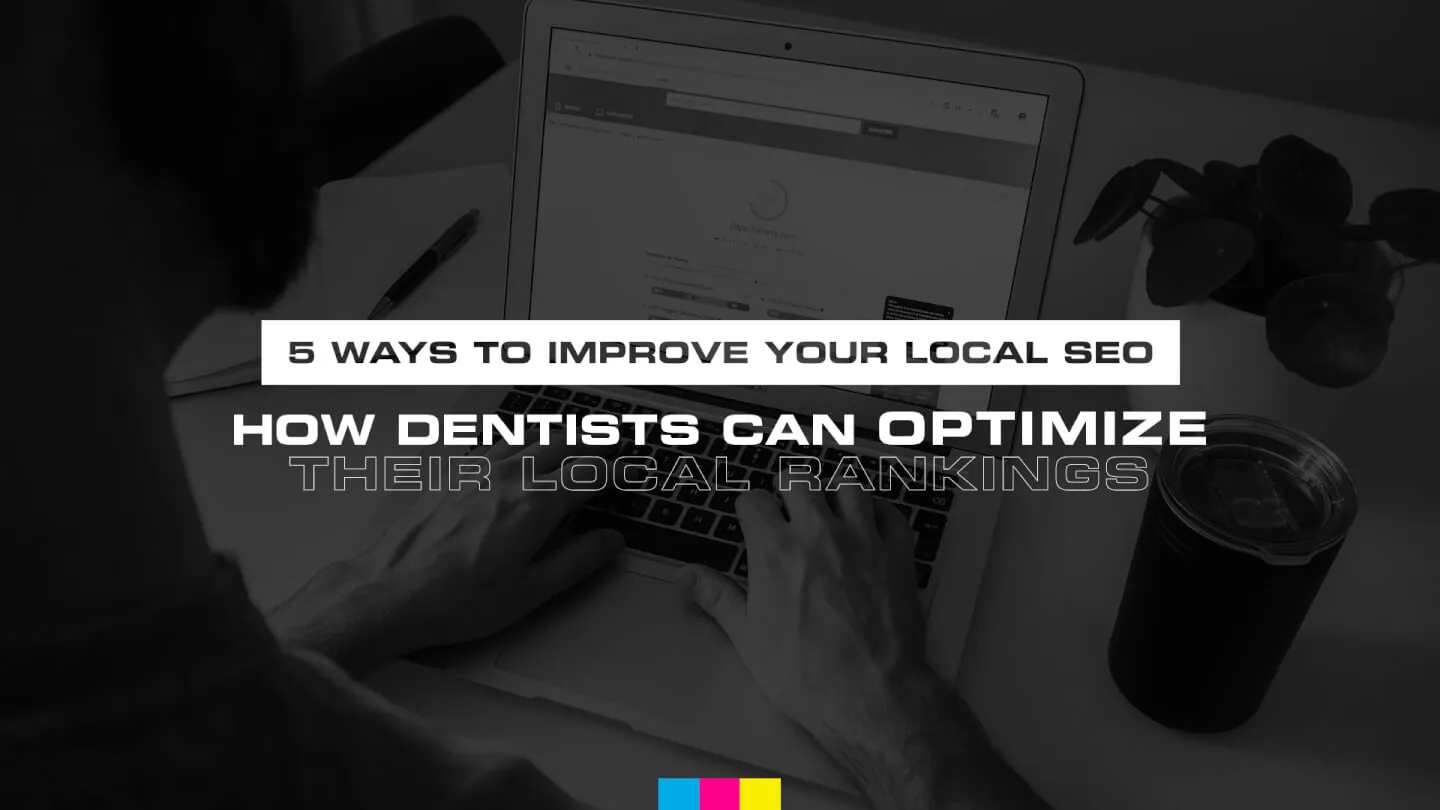5 Ways to Improve Your Local SEO
How Dentists Can Optimize Their Local Rankings
You’ve finally opened your practice doors, you’ve launched your brand new website, your staff is ready to go, and the ops are waiting to be filled with patients. It’s an exciting time – you’re the new dentist in town, the one bringing something extraordinary to the community that you know deserves a fresh take on dentistry. You’ve worked so hard, you’ve checked all the boxes, yet somehow, the patients aren’t coming. They don’t even know you’re there! You check Google – where are you? Page number what??
The fact of the matter is there is no magic button anyone can press that will instantly pull your website or listing to the top of Google. Ads might get you closer, but nothing comes with a guarantee when it comes to Google’s algorithm. So, in order to even attempt to hack the multi-billion dollar company, we need to play by their rules.
Thankfully, we know a thing or two about what those rules are, and what works for dentists when it comes to improving Local SEO rankings.
What is Local SEO?
On a general level, Local SEO is the way in which businesses can optimize their local business directories to have a consistent, relevant, engaging presence online. On a practical level, Local SEO is to rank higher on Google search results specifically. Google basically gives businesses an online local storefront, called your Google My Business Listing. You’ve probably seen these local storefronts without even realizing what they are. Some people call it the “Google 3-Pack.” These 3-pack search results appear in the map section of Google (or Safari, Bing, etc...), and they show the local businesses immediately around you that match your search criteria. Here’s a better visual:

Why Does Local SEO Matter for Dentists?
Simple: look at how search results populate, and in what order. First and foremost are ads, taking up at least 3 (sometimes 4) spots in search results before ever even getting to the local results. (If ever there was a time to remind you how important ads are, this is it.)
Next come the local results – the map section. For any business serving a local community (as opposed to nationally or globally), this area of search engine “real estate” is crucial to be competing in. These days, about 60% of all searches are done on a mobile device, and about 1 in 3 of those mobile searches are made with local intent. Meaning, people are in your community, on their smartphones primarily, looking for immediate, nearby, and trusted results. If those people are searching for “dentist near me” (which more and more people are each year , according to Google Trend data), by all means, make sure you’re doing everything in your power to help your practice show up.

Steps to Optimize Your Local Rankings:
1. Create and Optimize Your Google My Business Listing
Claiming and maintaining a Google My Business (GMB) listing compliments your already-existing website by giving it a public identity that, in effect, acts as your introduction to potential new patients. Here, they can see your address, phone number, photos, reviews, and more, all before actually landing on your website. Does it replace your website? No. Does it help drive relevant traffic to your website? Absolutely.
Creating or claiming your GMB listing is fairly simple, and free to do. Whether your practice listing already exists or not, you can either create or claim it by following Google’s step-by-step guide here. Both methods will require either phone verification steps and/or a mail-in postcard to verify the address you’ve entered, so while you’re waiting on Google to verify your listing, you can work to optimize it.
It’s one thing to add the core information (Name, Address, Phone Number, Website URL, etc.) to your GMB listing, but it’s another to optimize your profile further with all of the relevant details that will not only help Google identify who you are, but also help potential patients interact with your practice a lot more easily. Google’s primary goal is to provide relevant search results to users, so any way you can help that along, the better. Think about it like any other social media profile - you’ll want to add things like:
Photos & Videos: This gives the ability to show off your face and your space before patients even land on the website, helping to tell your story from the first interaction. According to Google, “Businesses that add photos to their Business Profiles receive 42% more requests for directions on Google Maps, and 35% more clicks through to their websites than businesses that don’t.”
Special Hours: Not only should you keep your normal business hours updated on GMB at all times, but you can also utilize the “Special Hours” tool that updates patients as to whether you’re closed for holidays, special events, or in emergency situations.
Appointment Link: This feature allows you to enter your online scheduling link directly to your GMB listing for easy, convenient scheduling for new or existing patients.
Local Posts: Similar to social media, Local Posts give you the ability to quickly engage and update your audience with offers, events, services, or changes to your practice. You can include links, images, and text just like you would on a social media post, but without the likes or comments.
Services: This feature enables you to provide at-a-glance dental service information for your practice. You can even include a short description and pricing information.
Business Description: Just like an “About” section on Facebook, this is a chance to give patients a taste of what your practice is all about. It’s also a chance to hit on some major keywords, so be sure to include them where it makes sense!
Special Attributes: These include details like whether or not your entrance is wheelchair accessible, what health and safety measures are taken for COVID-19 precautions, and what languages are spoken at the practice. Newer features allow Black-owned and women-led businesses to be highlighted on listings, too. For healthcare providers, Google now even has a place where you can highlight the insurances you accept.
2. Manage and Respond to Patient Reviews
One of the biggest areas of opportunity on GMB listings, which is often overlooked by dentists, is the work of gathering and responding to reviews from patients. Don’t think proactively gathering positive reviews is worth your time? Here are some statistics that might make you think twice:
- 91%: The percentage of consumers who say that positive reviews make them more likely to use a business.
- 82%: The percentage of consumers who read online reviews for local businesses.
- 13 minutes and 45 seconds: The time an average consumer spends reading reviews before making a decision.
- 76%: The percentage of consumers who trust online reviews as much as recommendations from family and friends.
Whether you work out an in-office system with your front desk staff, or use a review-generating system such as Swell or Birdeye, asking for reviews from patients can yield compounding ROI in the long-run. Not only will it help your Local SEO rankings over time, but it’ll help other potential patients in your area see how amazing you are without you having to say a thing. And, as we can see from real data, it works.
TIP: Don’t ask all of your patients all at once for reviews, as a huge influx of reviews on your GMB listing out of nowhere will be a red-flag to Google. There’s not a magic number with this, of course, but we do know based on experience that it’s best to ask patients in small batches over a span of time (ie. 5-10 people every week over 6-12 months). The benefit of asking new patients for reviews after their first appointment will help solve this, too, as your new patient appointments will naturally be staggered, and people are more likely to leave a positive review immediately after a pleasant interaction with a business.
The second part of this strategy involves actually responding to reviews. Yes, both the positive and negative reviews. If you’re not already doing this, there’s a ton of untapped potential to build your brand reputation through interacting with patients via the reviews on your GMB listing.
When responding to positive reviews, you can help affirm the patient’s experience, and echo your sentiment about how excited you are to have them as a patient. That human-ness (for lack of a better term) will read genuine (because it is) to those people who have just been introduced to you and your practice.
With negative reviews, it can become a little more challenging. It feels more personal, like a direct attack on your business, your team, and yourself. Because of that, it’s important to remember that getting a negative review does not spell the ruin of your practice. In fact, it’s a great opportunity to establish some positive brand reputation by addressing the concerns with a little grace, sincerity, and swiftness. The goal should be to diffuse any anger quickly, and take the conversation offline if possible, out of the public eye. We recommend a few simple DOs and DON’Ts to keep in mind when responding to negative reviews:
DO: Give yourself 24 hours to respond. Emotion burns hot, and your knee-jerk reaction, while in the moment feels righteous and justified, may prove more harmful in the long-run if you let yourself get worked up over someone’s public, negative feedback.
DON’T: Argue. It’s tempting, I know - they said a bunch of stuff that’s untrue, tarnished your good name, and are claiming up and down that you somehow wronged them or treated them badly. But to the point above about proving more harmful in the long-run, arguing with patients via reviews (or social media, for that matter) can come off as indignant, combative, rude, or straight-up petty. None of the things you want your brand to be known for. Remember, new patients are looking at these reviews - and your replies - to figure out whether or not they want to work with you. Having a bad attitude toward negative reviewers won’t make you look like the hero, it’ll likely do just the opposite.
DO: Take the conversation offline. Address their concerns, express empathy for their negative experience, and end your response by giving them a chance to discuss their concerns with you (or an office manager) directly via a phone call. This not only will take any further escalation out of the public eye, but it’ll help humanize your response and offer a chance to resolve the conflict one-on-one, which is often far more effective and impactful for patients.
3. Claim and Verify Other Online Local Listings
Part of a well-rounded Local SEO strategy includes taking up as much online “real estate” as possible, which is where local listings come in. Some are obvious, such as Yelp, Healthgrades, Facebook, and Bing. Others, like Amazon Alexa, Chamber of Commerce, EZLocal, City Search, HotFrog, and more, perhaps aren’t so obvious. Regardless, all of them are important.
These additional business directories serve to aid in your Local SEO rankings by allowing Google to cross-reference and verify the data from your GMB listing, further validating who you are. Each additional listing, whether it appears obscure to you or not, is one additional validation point for Google, and for patients.
There are tons of business directories where you could potentially add your practice information to help create reliable, consistent data across the web. Here at S8E8, we prioritize, claim, verify, and maintain around 80 business directories for the practices we work with. Some major directories that have high impact on Local SEO rankings are:
- Google My Business
- Bing Places
- Facebook Business Page
- Yahoo
- Yelp
- Healthgrades
- Chamber of Commerce
- YellowPages
- HotFrog
- Superpages
- MerchantCircle
- DexKnows
- eLocal
- Local.com
4. Clean Up and Update Your Social Media Profiles
Yes, your social media profiles are additional business directories that add to your overall online presence, and they carry a ton of impact in the Local SEO world. Facebook, Instagram, LinkedIn, and even TikTok are all ways in which you can help validate your business information and credibility, engage with new and existing patients, create a strong brand identity and reputation, and share your story.
Our Social Media Strategist has some super-duper helpful hacks for updating and cleaning up your social media profiles, that you’ll want to bookmark. No, really.
5. Use Location-Specific Website Copy and Tags
Any successful Local SEO strategy needs the support of a strong website to back it up. Want Google to know you’re a dentist in Tampa, Denver, or Sacramento? Make this clear on your website. This can be accomplished with ensuring your address is included on each page, your SEO Title Tags and Meta Descriptions are location-specific and contain your primary keyword, and your website copy as a whole contains your primary, secondary, and supporting keywords throughout.
It’s important to remember that you’re ultimately speaking to patients when it comes to the written content on your website, so it needs to sound like it’s written for humans first, and Google second. Our Lead Copywriter has outlined his process for successful storytelling in the article here, that will give you a ton of insight as far as what we mean when we say “story-driven website”, and what goes into the website copy as a whole.
Takeaway
Local SEO, as with most marketing strategies, is a long-term game. That means the small steps you take that make minimal impact now will compound over time to make a much larger impact in the future for your practice. You have to start thinking about Local SEO as essential to your overall marketing strategy, because without it, your practice will have a much harder time getting ahead of the competition in your community.
I get it, there’s a lot to set up, there’s a lot to maintain, and it seems like the second you get it all figured out, something changes. Google, amiright? Good thing you’ve got a killer team on your side. (It’s us, we’re the team.) Let us know how we can help.


.jpg)
.jpg)

